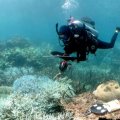Ecologists are weighing up the costs of conserving global biodiversity with a new study.
Dr Michael Bode, who undertook the research as a PhD student under the supervision of Professor Hugh Possingham at The University of Queensland's Ecology Centre, found that to effectively protect global biodiversity the cost of conserving different areas must be considered, rather than just the number of species found there.
Dr Bode said the research, developed with colleagues Dr Kerrie Wilson and Ms Marissa McBride and released in the current issue of the Proceedings of the National Academy of Sciences, could upset some biologists.
“We should worry more about costs of conservation and other socio-economic factors and obsess less about exactly what species is where,” Dr Bode said.
“This is something that often delays the process of making conservation decisions because we generally don’t have enough basic biodiversity information.
“Our research means that, in many cases, we no longer need to collect huge amounts of detailed, expensive biological information on where all these groups are found before we know where to act – we can act now.”
Dr Wilson said the planet was facing a global extinction crisis and many international conservation agencies and governments had established alternative, and often divergent, approaches to identify important areas for protection.
“Quite simply, the science behind prioritising areas for conservation has not been conclusive,” Dr Wilson said.
“Traditionally you would identify places where there are lots of species found nowhere else.
“If these places have lost a lot of their original habitat, then they are generally called ‘biodiversity hotspots’ and are considered key priorities for conservation spending.
“Important issues such as the relative cost of conservation are often not explicitly incorporated.”
Dr Bode said the official list of biodiversity hotspots was created in the late 1990s, supposedly to identify in which areas of the world would a given conservation dollar contribute the most towards slowing the current rate of extinction.
“Yet they didn’t consider cost,” Dr Bode said.
“The list of hotspots included Coastal California and the French Riviera.”
Professor Possingham said previous research with Drs Wilson and Bode had shown the importance of including costs in setting priorities.
“This paper makes our case more explicit by showing that areas like Coastal California and the French Riviera are too expensive,” Professor Possingham said.
“Places like Madagascar and the Horn of Africa give conservation agencies a much better return on investment from their biodiversity dollar.”
Dr Bode is currently employed at The University of Melbourne in two federally funded research centres, the Australian Centre for Ecological Risk Analysis and the centre for Applied Environmental Decision Analysis www.aeda.edu.au
Media: Dr Michael Bode (03 8344 5422), Professor Hugh Possingham (07 3365 9766, 0434 079 061), Dr Kerrie Wilson (03 8346 8604, 0418 873 237) or Andrew Dunne at UQ Communications (07 3365 2802 or 0433 364 181).
.jpg)


